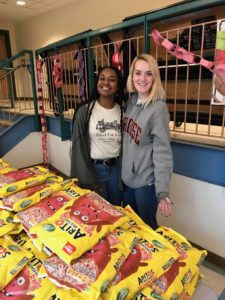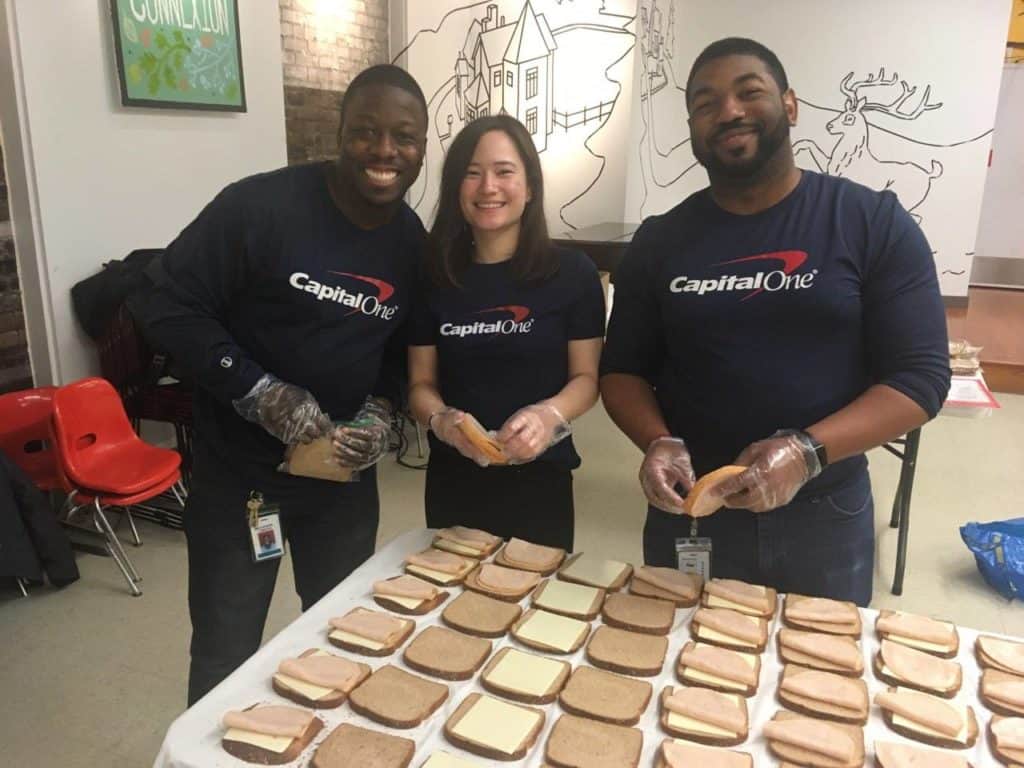Weekend backpack program FAQ
Frequently asked questions about starting your own Weekend Backpack Progam
What is a Weekend Backpack Program?
In Massachusetts, over 440,000 students qualify for free/reduced price school meals, and 1 in 5 children are considered food insecure. Our most at risk students for food insecurity are also the ones who are most affected by the achievement gap, and poor academic outcomes that can have lifelong effects. These students rely on their school cafeterias for the majority of their nutrition during the week. These supports do not exist over the weekend, so many school districts have Weekend Backpack Programs. Weekend Backpack Programs send food home discreetly on Fridays to ensure students are well fed over the weekend and can come in Monday mornings, ready to learn. Weekend Backpack Programs have been shown to decrease absenteeism, behavioral trips to the principal’s office, and trips the school nurse for hunger related ailments. All of these factors lead to more instructional time in the classroom for students, which lead to better academic outcomes for children living in poverty. This is a powerful argument to make when speaking with school administration about the need for a program in your school or district.
Frequently asked questions about starting your own Backpack Program
Our team has mentored many groups and individuals looking to start up Weekend Backpack Programs in their own communities. Here are some frequently asked questions that can guide you in starting your own program.
Once you determine that there is a need for such a program in your school, the first step is to schedule a meeting with your school principal to discuss the program, the need and how it might work. Make sure to do your homework before this meeting as it may be your only shot to sell your case!
Tips for talking with your Principal:
- Have the facts about your district, what %age of kids are eligible for F/R lunch but also, does your city provide data on poverty levels? What food resources already exist?
- Ask that the School Nurse or School Counselor attend the meeting as they may have anecdotal stories about students in your school that can help determine need.
- Have a plan for how the program can work logistically and who will pay for it. School administrators are often overwhelmed with curriculum requirements and the program will need to be low impact on the school staff in order to be approved
- Determine what your space needs will be before the meeting. Will you need onsite storage during the week/on Fridays? Will the bags be packed off site and delivered? These requirements will the school administration visualize the impact on space needed, which is often at a premium.
When asking for the meeting, you can send your principal this short interview that aired on RadioBoston in 2014 that may be helpful in showcasing how a school principal views this program and how it is helping their families.
Each program is different, but a general price range to think about is between $2.00-6.00 per bag depending on where food is purchased, how much labor is involved, and if you are purchasing in bulk.
Funding sources can vary from program to program, and even within a program it can vary from year to year! Some programs are supported by their local food bank or food pantry, some are 100% community funded through donations, some are funded through their local or state budget. We suggest at first, soliciting community donations to support the program, and using the opportunity to talk about childhood food insecurity in your community. Host a fundraising movie night with “A Place at the Table”, have a citywide panel discussion with local anti hunger advocates, initiate a social media campaign around childhood hunger and academic outcomes. Raising awareness of how prevalent the issue is in your community will help with funding. Figure out how much the program will cost per child, per year, and ask people to sponsor a student, or a family for an academic school year. Local banks and organizations are great places to apply for grants to help fund the program, local grocery stores are great places to connect with for donations or discounts on food. Think about connecting with your local elected officials, school committee/school board, city or town government leaders and your State Representatives and State Senators and engage them on issues of funding for your program.
If you aren’t a non-profit and don’t have a 501(c)(3) status, it is a good idea to find a non-profit that would be willing to take you on as a FISCAL SPONSOR. These organizations will help administer receiving donations and paying invoices in exchange for a small administrative fee. As you grow, you may want to look for a more sustainable home for you program in a non-profit that is serving the same mission in your community. If possible, it can be helpful to approach this non-profit in a time of success and stability in your program instead of a time of despair. Approaching the organization can be difficult, and fully preparing for this is important. Make sure to have your financials in line to show the full cost of the program, have a solid understanding or record of the number of hours spent on the program each week by staff and volunteers, and your plan for what this transition would look like.
The program should be open and available to any family in the school who needs it, and should have a rolling admission process. Families may need it for a few weeks, or months to get them through a difficult time, or need to be added mid-year due to a financial situation. Qualifying students based on participating in the Free and Reduced lunch program may miss many of the very students that need the program the most. These students may have families who:
- Do not understand the federal free/reduced lunch form
- Whose first language isn’t English,
- May have not returned the form on time
- Missed the cut off by just a few dollars
- Don’t want to sign a government form
When starting a program, making the time to understand the challenges and limitations of these income based programs will be critical and ensuring that any family that may benefit from having additional food on the weekend feels comfortable participating will be key.
Each school has a student support team that consists of the Principal, Assistant Principal, School Adjustment Counselor and School Nurse that meets regularly. This team would meet to discuss which students they think would most benefit from this program. It is important that they include the cafeteria manager in this conversation. The cafeteria manager is always the most knowledgeable in determining who is most in need because they know who comes back for seconds, and who steals or hoards food. You may want to keep participants unknown to you, keeping the privacy between the families and the school. To do so, the school will need to be responsible for signing up students and maintaining an up to date list. The school would then share the number of students participating, and no names would be used. On the other hand you may want to have more data about the students participating each year for record keeping. It will be important to determine if your program will have this firewall, or if you will require more data sharing.
An opt-in form* should be sent home with every student at the beginning of each school year. Once the forms are returned by the families, the student support team should cross check the forms against the students they had previously determined would benefit to ensure they signed up. If there are gaps in who has signed up, the team would reach out to the family personally to see if they are interested in having their children participate. Families may not fully understand what it means to be involved in the program or if they need to meet certain requirements. This is a time to clarify. If language is a barrier, the school may have translation resources that will help explain the program to the family.
*For a customizable sample opt-in in form, see forms (wherever this will be located on the webpage)
Yes. Each child in the home should receive a weekly bag of food, otherwise they will split the food. This includes children that may be too young to attend school.
 Food can come from a variety of places. You can open an account with your school department food supplier, which allows you to use their deep discount, but keep your own accounting/invoicing. You can also purchase food from Costco, and specialty items (like soy milk) from grocery stores. Your local food pantry may be able to donate certain items that you use a lot, like applesauce cups, mac n cheese, cans of tuna etc. You can also open an account with your food bank. These are a lot of options to purchase or receive free/reduced items.
Food can come from a variety of places. You can open an account with your school department food supplier, which allows you to use their deep discount, but keep your own accounting/invoicing. You can also purchase food from Costco, and specialty items (like soy milk) from grocery stores. Your local food pantry may be able to donate certain items that you use a lot, like applesauce cups, mac n cheese, cans of tuna etc. You can also open an account with your food bank. These are a lot of options to purchase or receive free/reduced items.
Yes, but we suggest that you ask for very specific things. For example, an item we use is shelf stable milk, but it is expensive and we use it each week. When corporations or groups ask if they can donate we ask them to do a milk drive. This ensures we get items that will help us cut costs and can be easily donated. Keep a list of items that people can easily donate that would be helpful to you. It’s important to try and keep food consistent across all students involved in the program. If you are soliciting donations for specific items, you might want to consider what happens if you don’t receive enough for all students. Will you purchase more? Or have another fundraiser?
- Mac-n-cheese cups
- Fruit/Applesauce cups
- Oatmeal packets
- Cereal bars/Granola bars
- Cereal cups
- Pretzels/chips
- Cup-a-soup
- Shelf Stable Milk
 Each program handles what type of food they send home differently; the bags can be all shelf-stable foods or can include fresh food which requires refrigeration and food safety handling. Some programs send the same food each week, some programs rotate the menu for more options and variety. In all cases, the bags typically contain 2 breakfasts, 2 lunches and some healthy snacks. These are the meals that students would have access to in a typical school day.
Each program handles what type of food they send home differently; the bags can be all shelf-stable foods or can include fresh food which requires refrigeration and food safety handling. Some programs send the same food each week, some programs rotate the menu for more options and variety. In all cases, the bags typically contain 2 breakfasts, 2 lunches and some healthy snacks. These are the meals that students would have access to in a typical school day.
*For sample menus from the Cambridge Weekend Backpack Program, see our 4 week menu
There are many dietary restrictions to be concerned about, including nut allergies and lactose intolerance, as well as dietary restrictions for personal or religious reasons, like students who are kosher, halal, or vegetarian. It is important to collect dietary restriction information on the opt-in forms and have this tracked by school. You can avoid these allergies and restrictions by having a nut free, dairy and meat free program, or you can develop a menu and system that helps to work to get each student a bag that is right for them.
Some programs mitigates these allergies by providing meat free, high protein sandwiches for the kosher/halal/vegetarian students, replacing sunbutter for peanut butter in sandwiches, replacing milk and cheese sticks with soy milk and meat sticks and more. It will be important to determine the level of organization that you want to take on with your own program.
 To ensure that this program is a light impact on school staff, Weekend Backpack Programs usually use parent volunteers, corporate groups and community members to pack the bags each week, either onsite or at a central location. Volunteers pack the bags onsite or deliver them on Friday morning and safely store them so that school staff can distribute them at the end of the day on Friday. Many corporations have social responsibility programs and organized days of service, and can bring their energy to your program. They have the added benefit of being future large scale donors. We suggest using an online volunteer site to organize volunteers, like Volunteer Spot or SignUp Genius to ensure you have enough hands each Friday.
To ensure that this program is a light impact on school staff, Weekend Backpack Programs usually use parent volunteers, corporate groups and community members to pack the bags each week, either onsite or at a central location. Volunteers pack the bags onsite or deliver them on Friday morning and safely store them so that school staff can distribute them at the end of the day on Friday. Many corporations have social responsibility programs and organized days of service, and can bring their energy to your program. They have the added benefit of being future large scale donors. We suggest using an online volunteer site to organize volunteers, like Volunteer Spot or SignUp Genius to ensure you have enough hands each Friday.
This depends on the type of program you have, and the type of food you send home. In many programs, they use plastic grocery store bags, or the black plastic bags you get at a liquor store which can be purchased in bulk. These bags are then placed inside a child’s existing backpack that go home. Other programs use reusable bags (insulated if they are sending fresh food home) that require students to bring them back each week to be refilled. Again, this just depends on each program and how they would like to organize weekly.
Over long weekends, or vacations you can send extra food home with students, but be mindful of the weight of each bag. For the winter break, think about sending home grocery store gift cards to cover food costs.
Big plastic tubs to store and tote food, and rolls of blue painters tape to label tubs. We use colored stickers to affix to bags that indicate if they are vegetarian, or nut free etc. for ease of distribution. If you are assembling any of the food on your own, you will need tablecloths that can be cleaned with a sanitizer spray, disposable gloves, and ziploc bags for appropriate items.
https://foodforfree.org/start-your-own-backpack-program/weekend-backpack-program-resources/At the end of each school year, you can send a sample survey for teachers to fill out for each child in their class who was enrolled in the program. Each child who is enrolled can be asked to advise which foods they liked and ate vs. which they didn’t. This can be done by having the child circle pictures of the foods they liked and crossing out the ones they didn’t. All of this data should be collected and reported out to the schools and to donors.
*For a customizable sample survey, it is located in our resources section here
It’s important to find a way to engage students in your program without making students who participate in the program feel embarrassed or uncomfortable. Maintaining the anonymity of students and families that participate in the program is extremely important, but bringing attention to your program is also very beneficial. One way to talk to students about hunger in their classroom and about your program is to engage with clubs at school. You might be able to talk to students that are part of a service club or in a classroom with a teacher that is an advocate for addressing childhood hunger.
In Somerville, this connection was made with the Roots & Shoots club at the Brown Elementary School. This club is part of Jane Goodall’s mission to bring youth together to address environmental, conservation, and humanitarian issues. Many of the students in the club couldn’t believe that there were students in their community that didn’t have enough to eat on the weekends. They decided to have a fundraiser for the backpack program and after lots of brainstorming, the students decided to host a table at the Somerville Winter Farmers Market to sell crafts that they made together. These students raised about $1,000 to help students in their community. Talking with students about hunger offers the opportunity for them to engage in a tangible way if they are interested in planning an action to address hunger. This is a really great opportunity to teach them about the difficulties that families face in their community.

